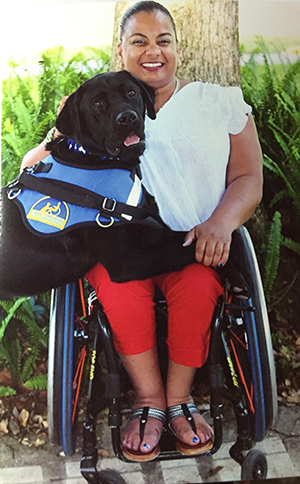Vanderbilt Kennedy Center (TN UCEDD, IDDRC, LEND) What we know about disability identity development
August 14, 2017

|
We learn a lot from other people about who we are as unique individuals and as members of groups. A well-articulated sense of self is a compilation of integrated, fluid identities based in contexts like gender, culture, ethnicity, sexual orientation, socioeconomic status, disabilities, and countless others. When we interact with others who are like us, we learn about our identities through the practices of mirroring, modeling, and recognition. An intact identity, formed in partnership with others, is critical for leading a healthy life, both psychologically and physically.
Research has a lot to teach us about what it means to develop healthy identities based on things like race and sexuality, but what research can teach us about developing a healthy disability identity is a slightly different story.
Reviewing the research literature
Anjali J. Forber-Pratt, Ph.D., assistant professor of Human & Organizational Development and Vanderbilt Kennedy Center (TN UCEDD, IDDRC, LEND) member, is one of the few researchers in the world who is studying disability identity development. She recently published a systematic review of the literature* to document what we know about the processes that individuals with disabilities go through as a disability identity develops.
"We only found 41 empirically driven studies that looked at disability identity development when we reviewed the literature, and that is problematic," said Forber-Pratt. "We just don't know very much about disability identity. What we did learn from our review is that disability identity may be considered, on its own terms, as a unique phenomenon that shapes individuals' ways of seeing themselves, their bodies, and interactions with the world.
We also learned that disability identity development has been studied primarily through qualitative methods that focus on individual experiences. This means we need larger studies with inclusive samples that factor in variables such as lifespan and type of disability. We can't be sure that conclusions we draw from these small studies have application across disability groups. How can we provide an awareness of disability identity for those who have a role to play in the lives of people with disabilities when we know so little about disability identity development?"
A psychosocial model
Prior to her review of the literature, Forber-Pratt conducted interviews with college students with disabilities to learn how individuals recognize a disability identity, and if they do recognize it, how do they describe it and its development? Her research team analyzed these data together, and the results of the study led to the establishment of a new model of psychosocial identity development for individuals with disabilities. The model outlines four developmental statuses: acceptance, relationship, adoption, and engagement.**
"Our model stresses statuses instead of stages," said Forber-Pratt. "Erik Erikson, a developmental psychologist, thought of identity development as being sequential. We move through the stages in an order, and we eventually achieve identity synthesis. I'm not so sure we can think about disability identity development in such a linear way. We have examples of individuals resonating with certain phases in different orders. We use statuses instead of stages to allow for both progression and regression among statuses. It also accounts for the fact that an individual may be in more than one status simultaneously, and even may go through this process multiple times in their lifetime. So for me, statuses makes more sense."
Forber-Pratt said that the study highlights the importance and challenge of meeting other people with disabilities and forming relationships to aid in the identity development process. Doing so can be a challenge as disability occurs in individuals who often do not have other individuals with disabilities around them. People with disabilities likely need to seek out others who are like them and this nuances synthesis in ways we do not yet understand.
"Human nature is such that we do seek out those who are like us," said Forber-Pratt. "Whether we do that as a part of integrating disability identity, we don't know that answer yet. But I do think we have to be ready to meet others like us. Some people may have a hard time accepting that they have a disability. They are in denial or are angry about what has happened, and so they may not want to spend time with others with disabilities. Then we also see there is a psychological piece of when you are ready to meet others like you. I believe there is likely a tipping point, but we don't know what that sweet spot is. So, if we can figure out what the ingredients are that lead to that sweet spot, then we can provide supports to get people there."
The research continues and Forber-Pratt's team is in the process of validating a measurement tool that they developed that looks at the statuses proposed in her disability identity development model.
"There are instruments out there that measure things like self-determination or self-esteem, but there is not a rigorous and reliable instrument that has been developed to measure disability identity in the way that we are framing disability identity," said Forber-Pratt. "An accurate measurement tool would further enhance the cultural competency of providers, and would inform effective interventions to support individuals and family members who may find themselves face-to-face with a new disability. When you consider that one in five Americans has a disability, we have an obligation to do this work and to better understand this unique developmental trajectory."
*Forber-Pratt, Anjali J., et al. "Disability identity development: A systematic review of the literature." Rehabilitation Psychology 62.2 (2017): 198.
**Forber-Pratt, A. J., & Zape, M. P. (2017). Disability identity development model: Voices from the ADA-generation. Disability and health journal, 10(2), 350-355.
Courtney Taylor is Vanderbilt Kennedy Center associate director of Communications and Dissemination







